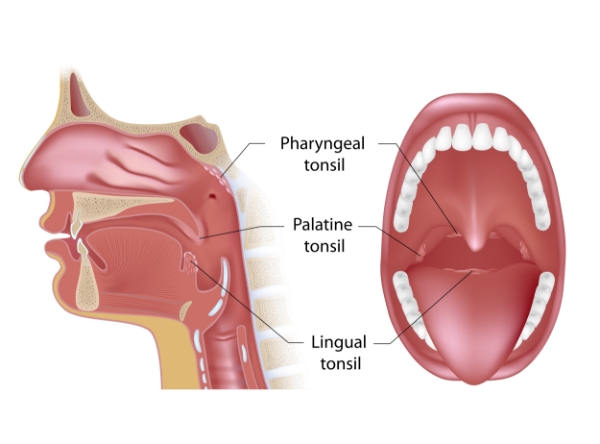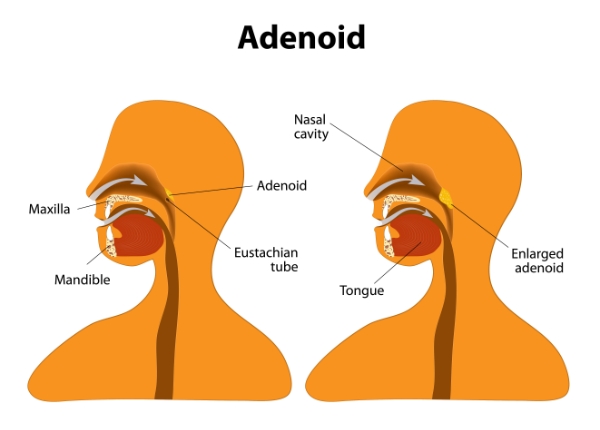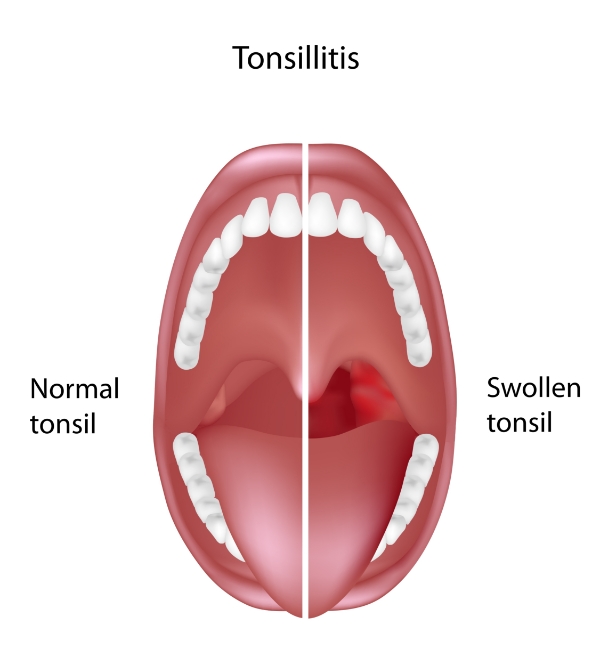Tonsils and Adenoids

Tonsils and adenoids are part of the immune system and help protect the body from disease and help fight infections. When bacteria or viruses enter the body through the mouth or nose, the tonsils act as filters engulfing the offending organisms in white blood cells. Unfortunately, sometimes they can get infected or cause problems by being too large.
The tonsils include the following types:
- Two palatine tonsils (tonsilla palatina)
- The adenoids (tonsilla pharyngealis)
- One lingual tonsil (tonsilla lingualis)
The two palatine tonsils are the two round lumps in the back of your throat (pharynx).
The adenoids are located high in the throat behind the nose and the roof of the mouth (referred to as your soft palate). They are not visible through the mouth or nose without special instruments.
The lingual tonsil is located far back at the base of the tongue on its rear surface.
Together, all tonsils form a ring around where the mouth and nasal cavity meet the throat. For this reason, they are called the tonsillar ring. This position allows them to trap germs like viruses or bacteria that could enter the body through the mouth or the nose.
Causes of Tonsil and Adenoid Problems
Infections cause the most problems with tonsils and adenoids, resulting in tonsil swelling and repeated bacterial infections. These infections can contribute to
- Breathing problems
- Nasal obstruction
- Swallowing difficulties
- Sleep problems
Most Common Tonsil Conditions
The most common tonsil conditions are:
Acute or Chronic Tonsillitis. Tonsillitis is an inflammation of the tonsils caused by a viral or bacterial infection. The infection causes swelling and a sore throat, and the tonsils may develop a gray or white coating. Chronic tonsillitis usually results from repeated episodes of acute tonsillitis or persistent infection of the tonsils.
Peritonsillar abscess. This occurs when an infection creates a pocket of pus next to the tonsil, pushing it toward the opposite side. Abscesses must be drained immediately.
Acute mononucleosis. This is an infection caused by the Epstein-Barr virus. It causes severe swelling in the tonsils, fever, sore throat, rash, and fatigue.
Strep throat. Streptococcus, a bacterium, infects the tonsils and throat, causing fever, neck pain, and a sore throat.
Enlarged (hypertrophic) tonsils. Large tonsils block the airway, making snoring or sleep apnea more likely
Tonsilloliths (tonsil stones). Tonsil stones are formed when trapped debris hardens or calcifies.
Symptoms of Tonsil and Adenoid Problems
Tonsillitis is an infection of the tonsils. Symptoms may include:
- Swelling of the tonsils
- Redder than normal tonsils
- A white or yellow coating on the tonsils
- A slight change in the voice due to swelling
- A sore throat sometimes accompanied by ear pain
- Uncomfortable or painful swallowing
- Swollen lymph nodes (glands) in the neck
- Fever
- Bad breath
If you or your child’s tonsils or adenoids are enlarged, it may be hard to breathe through the nose or cause difficulty while sleeping. Other signs of adenoid and/or tonsil enlargement include:
- Breathing through the mouth instead of the nose most of the time
- Nose sounds “blocked” when the person speaks
- A chronic runny nose
- Noisy breathing during the day
- Recurrent ear infections
- Snoring at night
- Restlessness during sleep, or pauses in breathing for a few seconds at night (this may indicate sleep apnea or other sleeping disorder)
Tonsil and Adenoid Problems Diagnosed
Your physician will ask about problems of the ear, nose, and throat, and examine the head and neck. They may use a small mirror or a flexible lighted instrument to see these areas. Other methods used to check tonsils and adenoids are:
- Throat cultures or strep tests to identify infections in the throat
- A small, flexible scope to visualize the size of the adenoids
- Blood tests to diagnose infections such as mononucleosis
- A sleep study, or polysomnogram, to help decide whether sleep apnea is present and if sleep disturbance may be due to enlarged tonsils and adenoids
Treatments for Tonsil and Adenoid Problems
Bacterial infections of the tonsils, especially those caused by Streptococcus, are first treated with antibiotics. Tonsillectomy, removal of the tonsils and/or adenoids (adenoidectomy), can be an option when infections return frequently even after antibiotic therapy or if there is difficulty breathing with the enlarged tonsils and/or adenoids.
Frequent infections of the adenoids can lead to frequent ear infections and a collection of fluid in the middle ear that may cause temporary hearing loss. Removal of the adenoids may help some children with chronic earaches accompanied by fluid in the middle ear (called otitis media with effusion).
In adults, the possibility of cancer or a tumor may be another reason for removing the tonsils and adenoids. In some patients, especially those with infectious mononucleosis, severe enlargement may obstruct the airway. For those patients, treatment with steroids (e.g., prednisone) is sometimes helpful.
Complications of Untreated Chronic Tonsillitis
Although tonsillitis itself isn’t serious, it can lead to complications if left untreated. Chronically enlarged tonsils can cause airway obstructions, which can lead to sleep apnea. In children, the effects of sleep apnea can be misdiagnosed as attention deficit disorder (ADD). In addition, oral and dental problems, such as halitosis (bad breath) and decay may arise if left untreated. A chronic sore throat and difficulty swallowing are frequently associated with chronic tonsillitis.
Contact Us
If you or your child experience the common symptoms of infected or enlarged tonsils or adenoids, please contact Integrated ENT at (303) 706-1616 to schedule a consultation for evaluation and treatment.
FAQs for Tonsillectomy
Tonsillitis is a process of infection that causes the tonsils to become painful and swollen. If this condition fails to clear with medical therapy, removal of the tonsils may be necessary. A tonsillectomy is typically performed to treat recurring or serious tonsil infections. This procedure may also be needed to treat patients with other issues caused by enlarged tonsils such as sleep apnea.
Yes, a tonsillectomy is usually done on an outpatient basis, and the patient should be able to go home the same day of the surgery. In some cases, however, the patient may be kept overnight.
In some cases, your doctor may recommend removing obstructive adenoid tissue along with the tonsils. Current research indicates that removing adenoid tissue during a tonsillectomy can reduce the risk of recurring infections and the need for additional surgery.
Although tonsillectomy surgery is safe, there are several postoperative symptoms that may arise. These may include swallowing problems, vomiting, fever, throat pain, and ear pain. Occasionally, bleeding from the mouth or nose may occur after surgery. If the patient (adult or child) has any bleeding, contact the surgeon immediately.
Common side effects of a tonsillectomy procedure include bad breath, fever, ear pain, and a sore throat lasting 8-10 days. Some children may notice a change in their voice. You may also notice that their tongue or palate is swollen or that the throat has yellow, green or gray patches. These patches are scabs, which will go away as healing occurs. In rare instances, children will have bleeding after surgery, but a consistent intake of fluid and minimal activity sufficiently decreases the chances of this occurring.
After tonsillectomy surgery, staying well-hydrated will decrease pain and improve recovery. Drinking liquids regularly are very important. While diet should be limited to softer foods, such as popsicles, ice cream, mashed potatoes, and macaroni and cheese, it is ok if the patient doesn’t feel like eating.
In terms of postoperative medication, pain medications work best when taken on a regular schedule for the first 4 to 5 days after surgery. A combination of acetaminophen and ibuprofen is recommended, but avoid aspirin as it can lead to an increased risk of bleeding. In some instances, your child may be prescribed a stronger narcotic for pain management. Additionally, your child may be prescribed the steroid Orapred, which helps with pain and inflammation.
Immediately following a tonsillectomy surgery, you should set aside time to rest and recover. While every patient is unique and recovery times vary for each individual, complete recovery usually takes 2 weeks but most children can return to school 1 week after surgery.
To facilitate recovery, engage in light activity only, and avoid any strenuous physical activity for 2 weeks after the surgery.
Follow these easy suggestions to help you or your child bounce back from surgery without issue:
- Rest and recover for 1-2 weeks
- Keep hydrated and eat soft foods
- Avoid strenuous activity
- Take pain medications on a regular schedule
The standard procedure is to have a follow-up appointment with your doctor 1 month after the procedure.











